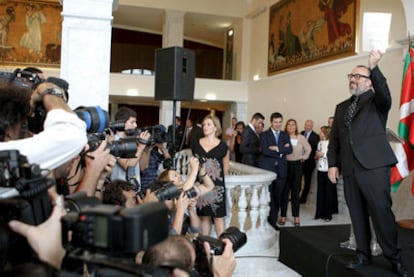Gender equality reaches prize juries
Anger and confusion as ministry opts to delay film prize in favor of balanced judges panel
It was an unexpected decision, one that left everyone inside Room 4 of the Culture Ministry looking puzzled. Four women and nine men were about to take their seats on Monday to choose this year's winner of the National Film Award. That was when the director of the Institute for Cinematography and Audiovisual Arts (ICAA), Carlos Cuadros, walked in and dropped the bomb: "We have a problem, and so we have to cancel this meeting." There were looks of disbelief.
The decision is a watershed in gender-equality policies. Cuadros, who was presiding his first National Film Award after replacing Ignasi Guardans at the helm of ICAA, went on to explain. The makeup of the jury, as published in the Official State Gazette on July 12, did not comply with the gender parity requirements set forth in the 2007 Law for the Effective Equality between Women and Men.
There were, in fact, only three women on the jury who could vote ? the fourth was an ICAA employee acting as jury secretary ? compared with nine men. That is to say, a proportion of 30 percent, when the law recommends that neither sex should have less than 40 percent representation. Article 51 of this piece of legislation states that government agencies must "promote a balanced presence of women and men in selection and evaluation committees." Article 26 specifically urges public authorities to respect and guarantee "a balanced representation" in advisory and decision-making bodies within art and culture agencies.
Regardless of whether ICAA leaders should get some blame for waiting until the day of the meeting to announce their decision, given that the jury makeup had been known for a week, a question still remains: is parity mandatory? If that particular jury had proceeded to select a winner, would their decision be illegal, or just questionable and open to improvement? The letter of the law, which proffers more recommendations than strict rules (except for electoral lists), shows that the vote would have been perfectly legal. The jury makeup would, however, have violated the spirit of the law.
For instance, the jury of the last National Spanish History Award, which went to Pablo Fernández Albaladejo for his work La crisis de la Monarquía, was made up of eight men and two women. The National Poetry Award was decided by three women and 10 men. It was a different story with the National Essay Award, whose jury included five women and eight men.
But this kind of gender imbalance is not just visible in the Culture Ministry. The National Design Award, granted by the Science and Innovation Ministry, had just one woman in the six-member jury. According to a ministry spokesman, parity will be sought at the next edition of the award. Meanwhile, the Health, Social Policies and Equality Ministry does not have data on the jury makeup for public awards.
The Culture Ministry, led by Ángeles González Sinde, has taken a step in favor of greater gender balance. A spokesman said the ministry is "very aware of the parity issue," and said that a recently published resolution states that for all the upcoming national awards organized by the Books, Archives and Libraries agency, each participating group must name two representatives, a man and a woman, which the department will choose from in order to maintain jury parity.
This was not the case at ICAA, which did not publish any such resolutions. But Carlos Cuadros says that he is determined to observe the law fully.
"In the end, it's very important to put this issue on the map. We preferred not to call off the meeting, and to let the whole jury show up in order to explain the situation. Everyone unanimously agreed to accept the ICAA's proposal. Our obligation as a public agency is to observe the Equality Law and to set a good example. I was surprised at the media reaction, but I'm glad because it will set an example. This is everyone's responsibility," Cuadros told EL PAÍS.
A few months ago, the ICAA director also established that film grants for female directors must enjoy the same benefits as the grants for new directors, regardless of whether the woman director is shooting her first, second, third or fourth film.
And so the jury of the National Film Award will change by Friday, if there is time to get the new list of names published in the BOE. It was agreed that three of the participating associations ? the Film Academy, the Literary Authors of Audiovisual Media and the Federation of Artists ? will switch to a female representative.
Although the jury members did not criticize the Equality Law, some were angry at the way things were handled.
"They could have at least warned us in advance so we could have saved ourselves the trip," said one member.
"I find it a complete lack of trustworthiness that they realized today, when the names have been published for a week in the BOE," said Pedro Pérez. "I regret that a prize known for the prestige of past winners should start out this year with serious defects of form, when it should have been impeccable."
But some saw the upside. "I think it's great that the Culture Ministry decided to have balanced juries," said Cristina del Valle, president of the Platform of Women Artists against Gender Violence. "Female citizens make up over 50 percent of the population and we must be represented in all public spaces."








































